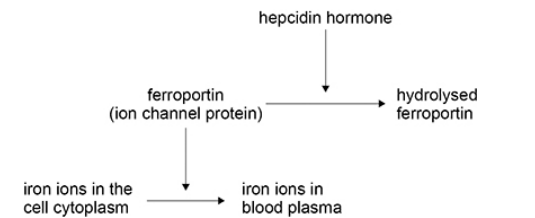A Level Bio 1.8 Inorganic Ions
1/5
Earn XP
Description and Tags
Name | Mastery | Learn | Test | Matching | Spaced |
|---|
No study sessions yet.
6 Terms
Doctors investigated the link between high sodium concentrations in medicines and hypertension (high blood pressure). They analysed medical records of patients.
1 292 337 of these patients had taken medicines containing high sodium concentrations. Each of these patients was paired with a patient from a control group
Give two factors that should have been the same for each pair of patients and one factor that should have been different (2)
Same
Accept any two of the following for one mark
1. BMI, age, sex/gender, other/previous medications, ethnicity, diet,
exercise, health (issues
Different
No sodium in the (same) medicine (1)
Give two roles of phosphate ions in cells (2)
In DNA or in RNA (1)
phosphorylation(binds with substance to make it more reactive (1)
Scientists measured the concentration of inorganic ions in the cytoplasm of mammalian cells and in the tissue fluid surrounding those cells.
In these mammalian cells, the:
• cell-surface membrane is permeable to sodium ions
• sodium ion concentration does not increase in the cytoplasm over
time.
Use this information and the graph above to suggest and explain the ion
transport mechanisms involved in the transport of sodium ions (2)
(Sodium) ions move in (to cells) by facilitated diffusion down a concentration gradient (1)
(Sodium) ions move out (of cells) by active transport against a concentration gradient (1)
Explain a property of iron ions that enables these ions to carry out their role in red blood cells
Is charged/polar accept Fe2+or Fe3+ for ‘charged (1)
so binds (with) oxygen (1)

The hormone hepcidin controls the iron ion concentration in blood plasma.
Hepcidin affects ferroportin, the iron ion channel protein in cell-surface membranes.
The figure below shows how hepcidin controls the iron ion concentration in plasma.
People with the disease haemochromatosis do not produce hepcidin.
Use information in above figure to explain why the iron ion concentration is higher in the plasma of people with haemochromatosis. (3)
Less/no ferroportin hydrolysis/breakdown (1)
(So) more ferroportin (in cell-surface membranes) (1)
(So) more iron (ion) transport from cytoplasm/cell (1)
Describe the roles of iron ions, sodium ions, and phosphate ions in cells.(5)
Iron ions
Haemoglobin binds/associates with oxygen (1)
Sodium ion
Co-transport of glucose/amino acids into cells (1)
Creates a sodium concentration/diffusion gradient (1)
Affects osmosis/water potential (1)
Phosphate ions
joins nucleotides (1)
Hydrophilic part of the phospholipid bilayer (1)